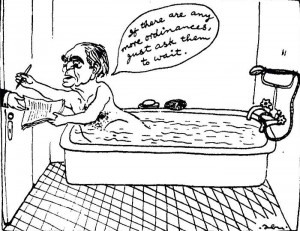Reading the excerpts of Sanjay Baru’s book on Prime Minister Manmohan Singh, The Accidental Prime Minister (http://bit.ly/1iawxNv), I am somehow reminded of a cartoon that was done by the brilliantly nonchalant Abu Abraham. Published in the tumultuous period of the Emergency, it shows a rather ungainly President in the bathtub, signing off the proclamation. Indeed, on midnight of June 26, 1975, the office of the President of India was delivered such a body-blow, that it has not recovered even till today. Not surprisingly, the president of the nation, was considered to merely a rubber-stamp, a puppet in the hand  of the government, who signs off the bill, the ordinances, proclamations of Presidents Rule, etc., living off the lard in a cosy colonial palace, the Rastrapati Bhavan. Indira Gandhi, who selfishly wanted to avoid the embarrassment of having to resign following a verdict of Allahabad High Court, decided to enact the most brazen and oppressive abuse on Indian democracy. The rest of the government, including the President, were merely stooges or at-best hapless no-bodies, who could no nothing.
of the government, who signs off the bill, the ordinances, proclamations of Presidents Rule, etc., living off the lard in a cosy colonial palace, the Rastrapati Bhavan. Indira Gandhi, who selfishly wanted to avoid the embarrassment of having to resign following a verdict of Allahabad High Court, decided to enact the most brazen and oppressive abuse on Indian democracy. The rest of the government, including the President, were merely stooges or at-best hapless no-bodies, who could no nothing.
Somehow, the stratagem that was deployed by Indira in 1975, was mastered by her daughter-in-law in 2004, who foisted on a nation a political cipher as a prime minister, just to warm the seat for the eventual transition to her son, Rahul Gandhi. Manmohan Singh as a prime minister in 2004, was as much as an accident as much as it was a design. Just like her mother-in-law, who was under fire for electioneering crimes, Sonia Gandhi was under pressure over her Italian root. The then President APJ Kalam too had apparently raised the issue of her origins, and showed reluctance in ordaining her as the PM. After having burnt her fingers with a thankless PV Narsimha Rao and ambitious Sitaram Kesri, Sonia decided to find a PM that was not only pliable and amenable, but also deferential to the 1st family, and drawing his support from the family itself. Thus by a curious tragedy, in 2004, we never really got a prime minister but rather a care-taker prime minister, someone who was always “caring” the needs of the family and careful not to fall out of favour with his mentors.
While the stratagem deployed by Sonia Gandhi was vintage Congress-stuff, the implications and ramifications were far wider. Over the course of reign from 1966 down to 1984, Indira Gandhi had ruthlessly destroyed all the power-centres that could pose a challenge to the PMO. Stooges were given positions of power, and those who stood in the way were somehow sidelined and cut to size. For instance, not many were surprised when Giani Zail Singh on being made the President had apparently remarked, that “If my leader had said I should pick up a broom and be a sweeper, I would have done that. She chose me to be President!”. Little wonder, when Operation Bluestar was launched, the President did not even know a thing about it beforehand. India was Indira, and Indira was India, truly speaking. Continue reading
